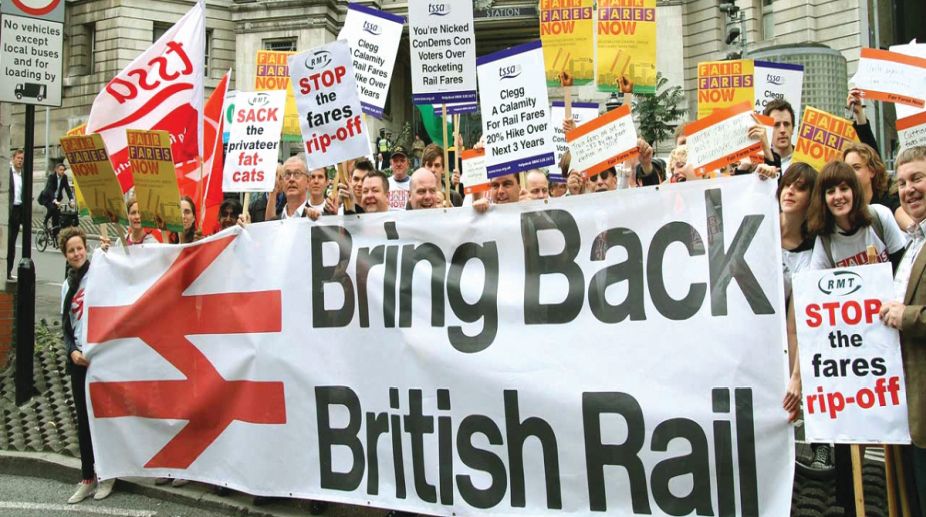In the US and the UK, privatisation is barreling in opposite directions. President Trump unveiled a national infrastructure programme that places control of targeted roads, bridges and utilities in the hands of highly subsidised private developers.
The public bears all the risks of underwriting these projects while private developers take the profits. The public pays twice, first for the construction projects themselves and then in fees for daily use of publically funded assets.
Trump’s scheme may not survive the November midterm elections when Democrats have a crack at regaining the Senate and perhaps both houses, but it is the purest expression of modern con artistry.
The UK meanwhile is coping with the costly repercussions of the collapse in mid-January of its second largest construction company, which looks like an overdue turning point in their woeful experiment with privatising panaceas.
Privatisation surged in the 1980s, led politically by Ronald Reagan in the US and Margaret Thatcher in the UK, in the guise of an easy solution to budgetary constraints, not because of failures or shortfalls in public services.
Free market zealots insist that profit enterprises by definition are more efficient than the public sector at any task, which simply isn’t true. Developers everywhere rubbed their hands in glee.
The World Bank, as part of its economic catechism, requires that borrowing nations privatise their public sectors.
The purpose of this ludicrous requirement has nothing to do with improving living standards for ordinary citizens; rather, it is imposed to create investment opportunities for corporations and for the several hundred billionaires who own more wealth than half the population of the planet.
The Swiss bank Credit Suisse reckons, as a result of an anti-Union climate, untouched tax havens, rampant deregulation and routine tax cuts for the rich, the top 1 per cent own more assets than the bottom 99 per cent. The richest 10 per cent own 87 per cent of the world’s wealth. That means there is an awful lot of surplus money ~ otherwise paid out in higher wages, better benefits and improved public amenities ~ which has to try every trick there is to make a nice return.
That is the primary motive behind the drive to privatise, not any sober findings that private firms serve the public better in health, education, transport, water, or power generation. (Hence, property markets bulge into obscene unaffordability in cities like New York, London and San Francisco because elites need places to park their excess loot).
Privatisation also means selling off public assets at cut-rate price, and usually further gifting buyers with tax breaks, incentive packages and profit guarantees. CEOs do love to denounce “big government” while feeding at the generous public trough.
The British National Health System (NHS), for example, is incomparably more efficient and humane than the American private system. There is an ethos there of genuine pride in public service.
Many people are delighted to step outside the casual cruelties of the economic system. The Tories and “New Labour” under Tony Blair devised stealth forms of privatisation that put parts into private control while honouring the mantra of “providing care free at the point of delivery.”
The Tories loudly proclaim they put vast sums in to the NHS that actually go into private initiatives that enrich their cronies. For a glimpse of the ultimate costs, Polly Toynbee and David Walker noted in their 2011 book, The Verdict that the UK Treasury figured the lifetime burden of just the New Labour deals were 215 billion pounds for projects with a capital value of between 55 and 65
billion pounds. Four times what they are worth.
Privatised British Energy, in charge of nuclear power, failed and had to be restored, expensively, in public keeping. The collapse of Metronet, a major private player in running London’s Underground, also cost the public purse several hundred million pounds. The state raising its own funds and operating its own public enterprises is cheaper and more effective in the long run.
Now comes the debacle of the huge UK firm, Carillion, at a cost that largely will be paid from the public purse. Carillion collapsed in mid-January with pension liabilities of nearly a billion pounds and owing 2 billion to subcontractors.
The state will take on the pension liabilities while most subcontractors are likely out of luck. Just like the 2008 crisis, four accountancy firms as supposed watchdogs never saw the collapse coming, which indicates either incompetence or corruption was in play.
“It beggars belief that a company can be allowed to run with such apparent recklessness ~ and be so lucrative for the directors and shareholders ~ when it has a giant pension deficit and a mountain of debt,” said Labour MP Frank Field.
Carillion’s CEO, a former adviser to Tory prime minister David Cameron, was found guilty in 1994 of a breach of trust and maladministration regarding the pension scheme at another company yet slithered into this position.
Perhaps we need the same alert system for CEOs like this as we do for paedophiles since they do vastly more harm. Not a single official bothered to meet with Carillion, or its subsidiaries, in the year before its collapse despite shelling out four major government contracts to Carillion worth £1.5 bn.
Labour vows to end private schemes. The Tories will try to keep spigots open for their pals. Americans, who seem to be the slowest learners in the world, may find from the UK’s experiences that FDR’s New Deal and Eisenhower’s highway programme weren’t such a bad way to build infrastructure. That’s how they got most of it in the first place.
The writers are well-known commentators and authors of No Clean Hands, Parables of Permanent War, and many other books.











